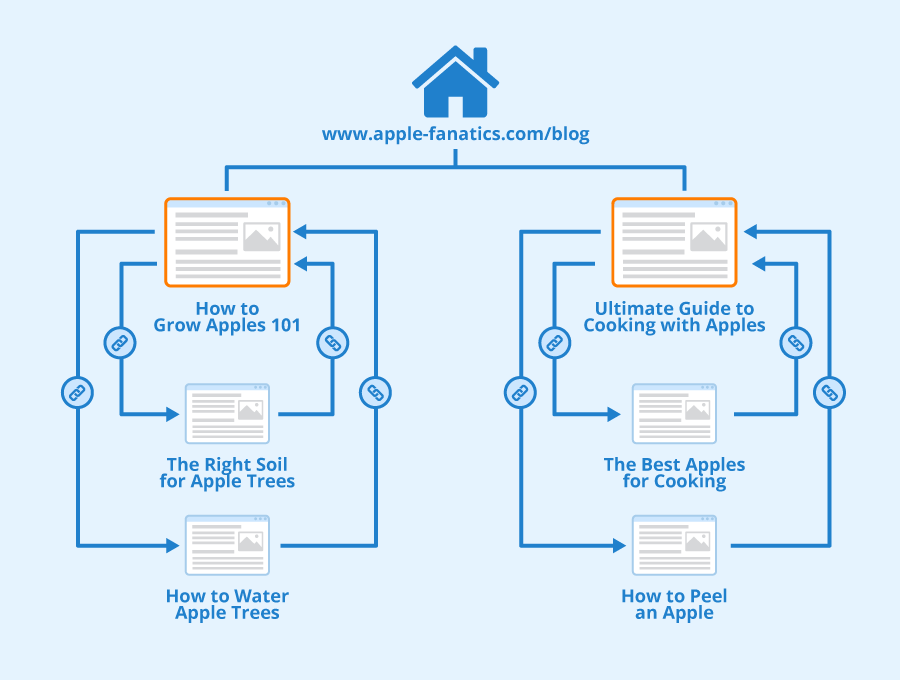How to Leverage Topic Clusters to Boost Your SEO
By RG team · 7 min read
Last Updated on June 11, 2023
Wait a minute...

Introduction

As a content creator, you know how difficult it can be to come up with fresh, relevant, and engaging content ideas consistently. One strategy that can help you streamline your content creation process and produce more effective results is topic clusters. In this article, we’ll explain everything you need to know about topic clusters, their importance in content creation, and how DRIPS.AI can help you generate them for trending topics using AI technology and massive data.
A topic cluster is a group of content pages or pieces that revolve around a central subject or topic and uses a pillar page to connect and from which to branch out. For instance, in a blog discussing the topic of 'food,' a topic cluster may center around different food groups like vegetarianism, wine, or recipes. By organizing multiple pieces of content into topic clusters, you can offer your audience a range of in-depth solutions to their problems, showcase your industry expertise and authority, offer them a breadth of helpful, comprehensive material.
Moreover, creating topic clusters is an essential part of SEO and search engine ranking. Topic clusters show Google that your website has industry expertise and offers in-depth material about substantial themes in your field, allowing the search engine to comprehend the hierarchy of your website and how your content interrelates. Thus, creating topic clusters is integral to improving your website's traffic, search visibility, and user engagement.
In the subsequent sections of this article, we’ll dig deeper into how you can create topic clusters to boost your content creation and SEO, classic examples of topic clusters, and how DRIPS.AI can help you take your content creation to the next level.
What Are Topic Clusters?
To put it simply, topic clusters are groups of related content that collectively cover a broad subject area. This collection is built on a hub-and-spoke model, with a high-level central page, known as the pillar page, that links out to related subtopics and individual content pieces. The combination of these subtopics and individual content pieces constitutes a topic cluster. When a user navigates to the pillar page, they can access related content on subtopics by clicking through to the relevant content pages, thus leading to improved content engagement.
For example, imagine a pillar page that discusses 'content marketing.' The topic cluster created around this subject matter might include individual pieces on subtopics such as 'content calendar,' 'content strategy,' 'social media marketing,' 'email marketing,' and 'search engine optimization.' All these individual pieces could link back to the pillar page, creating a comprehensive set of related content pieces.
The importance of topic clusters cannot be overemphasized in content creation. Firstly, they offer comprehensiveness, depth, and variety of information to your readers. Secondly, they assist in organizing your website content in a logical, hierarchical order, which makes it easier for Google and other search engines to interpret your content. Finally, they improve your SEO results by helping you rank higher on search engines and stand out from competitors, leading to an improved traffic flow to your website.
In the next section, we'll highlight how you can generate your topic clusters using DRIPS.AI.
How to Identify Topic Clusters
While the concept of creating topic clusters may seem daunting, the process of identifying them is relatively simple. To identify topic clusters, you can follow these steps:
1. Chart out primary issues: Begin by listing the primary issues that your target audience may face, including their pain points, problems, and interests. Do thorough research on your audience, your industry, and your competitors to ensure accuracy and relevancy.
2. Group issues into broad topic areas: After compiling primary issues, categorize them together and group them into broader subjects or topics. This step is likely to reveal a potential topic cluster as you may find some topics are closely related.
3. Identify keywords: After grouping your primary topics, it's time to identify relevant keywords. Use tools such as DRIPS.AI, SEMrush, Google Keyword Planner, or Ahrefs to determine what keywords have the maximum search volume. Make a comprehensive list of these keywords for each group or topic.
4. Flesh out core topics with subtopics: After identifying the core topics and keywords for each group, identify relevant subtopics and conduct research to expand the low-ranking ones. According to MarketMuse: To effectively use subtopics in your topic clusters, you'll need to have an understanding of a few important ideas: grouping, hierarchical structure, and the use of related keywords.
By following these steps, you can identify and map out your topic clusters, giving you a clear strategy and concept for developing your content.
Next, we'll highlight the importance of topic clusters for SEO and content creation.
Why Are Topic Clusters Important?
Apart from improving content comprehensiveness, topic clusters aid in organizing your website content in a logical, hierarchical order that makes it easier for Google and other search engines to interpret your content, thus providing several benefits to your SEO and website traffic.
One benefit of topic clusters is that they allow you to link your subtopics to a pillar page, which becomes a central page with high-quality backlinks. Internal linking, in turn, builds the authority and relevance of the pillar pages, leading to improved SEO rankings in the search engine results page (SERP). Another benefit is that it allows you to improve the dwell time (amount of time spent on a website), as a visitor may stay on your site to read multiple pieces, which strengthens your content marketing efforts and results.
By making your website more organized and relevant to the right audience, you can increase dwell time, decrease bounce rate, and increase your chances of ranking higher in search engine results pages. Topic clusters show Google that your website has industry expertise and offers a breadth of helpful, in-depth material about significant themes. This type of content helps Google understand the hierarchy of your website and how your content relates to one another.
In the next section, we will discuss how you can leverage DRIPS.AI to create topic clusters and create high-quality content that boosts your SEO rankings.
Topic Clusters and DRIPS.AI

As a content creator, generating fresh content ideas can be a challenge, which is why you need DRIPS.AI, the innovative platform designed to support content creators, marketers, and entrepreneurs. DRIPS.AI offers a suite of tools that make trend discovery, competition finding, and content creation all intuitive and effective.
Through DRIPS.AI, you can leverage data, including related competitors, keywords, and trends, to generate topic clusters for trending topics and to ensure your content is up-to-date and unique. DRIPS.AI pursues an all-encompassing approach to content creation that resonates with the modern-day audience. With DRIPS.AI, you can:
1. Discover trends: DRIPS.AI is designed primarily to analyze vast amounts of data and identify emerging trends, the players within the trends, and new opportunities. You can enter a brief description of your project, and DRIPS.AI will provide relevant trend matches. This allows you to align your campaigns with growing market trends, enhancing your chances of success.
2. Discover competition: DRIPS.AI also aids in competitor discovery, helping you identify key players who could augment your content's reach. This can help you identify areas of opportunity and the best way to create topic clusters around specific topics, ensuring a focused and effective approach to content creation.
3. Generate content: Using its powerful built-in AI technology, DRIPS.AI can assist you in generating new articles, videos, and podcasts that meet modern-day standards. This way, you don't have to worry about generating content manually, reducing your time and effort investment, allowing you to focus on higher-value tasks.
By leveraging DRIPS.AI, you can streamline your content creation process, create effective topic clusters, and generate fresh content ideas with the least effort. Moreover, by relying on DRIPS.AI to optimize your website content and make it more user-friendly, you can drive more traffic to your site, boost engagement levels, and maximize your ROI.
Conclusion
Topic clusters are essential for improving the SEO performance of your website and offering your audience a range of in-depth solutions to their problems. DRIPS.AI, with its suite of tools for finding contemporary trends, analyzing competition, and generating unique content ideas through its AI technology, can help streamline your content creation process and generate effective topic clusters. By leveraging DRIPS.AI, you can increase your website traffic and engagement levels, generating maximal ROI on your content creation and optimization efforts.



